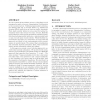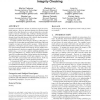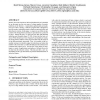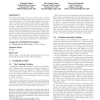CCS
2009
ACM
14 years 6 months ago
2009
ACM
Social networking sites have come under criticism for their poor privacy protection track record. Yet, there is an inherent difficulty in deciding which principals should have acc...
CCS
2009
ACM
14 years 6 months ago
2009
ACM
Large-scale distributed systems have dense, complex code-bases that are assumed to perform multiple and inter-dependent tasks while user interaction is present. The way users inte...
CCS
2009
ACM
14 years 6 months ago
2009
ACM
Security decision-making is hard for both humans and machines. This is because security decisions are context-dependent, require highly dynamic, specialized knowledge, and require...
CCS
2009
ACM
14 years 6 months ago
2009
ACM
Anomaly detection for network intrusion detection is usually considered an unsupervised task. Prominent techniques, such as one-class support vector machines, learn a hypersphere ...
CCS
2009
ACM
14 years 6 months ago
2009
ACM
In both commercial and defense sectors a compelling need is emerging for rapid, yet secure, dissemination of information to the concerned actors. Traditional approaches to informa...
CCS
2009
ACM
14 years 6 months ago
2009
ACM
CCS
2009
ACM
14 years 6 months ago
2009
ACM
Third-party cloud computing represents the promise of outsourcing as applied to computation. Services, such as Microsoft’s Azure and Amazon’s EC2, allow users to instantiate v...
CCS
2009
ACM
14 years 6 months ago
2009
ACM
Botnets, networks of malware-infected machines that are controlled by an adversary, are the root cause of a large number of security problems on the Internet. A particularly sophi...
CCS
2009
ACM
14 years 6 months ago
2009
ACM
Tor is an anonymous communications network with thousands of router nodes worldwide. An intuition reflected in much of the literature on anonymous communications is that, as an a...
CCS
2009
ACM
14 years 6 months ago
2009
ACM
As a result of physically owning the client machine, cheaters in online games currently have the upper-hand when it comes to avoiding detection. To address this problem and turn t...




